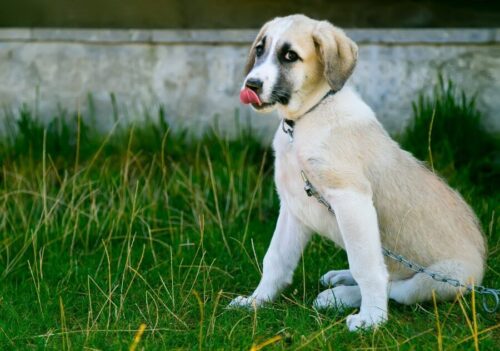Trigger stacking means any situation that triggers a dog’s fear, anxiety, or negativity. These triggers stack up. The situations usually happen one after the other until a dog passes its level of coping, even to the point of being unable to focus on you. Eventually, a dog will reach ‘above threshold’, with stress levels peaking. A single, perhaps trivial event can tip your dog over the edge and cause an extreme reaction: snapping, biting, snarling or lunging.
Each dog is different. Be aware of your dog’s body language and recognise what makes your dog scared, especially if your dog has a nervous disposition. Compare your dog’s body language to the Ladder of Aggression, which lists signs and stress levels it equates to. Work with your dog to avoid situations that cause trigger stacking.
At first, the warning signs given by a dog will be subtle. These signs are more significant if ignored, and adrenaline increases until a single incident pushes a dog over the edge. Then, out of character, a dog snaps, snarls, bites or lunges as cortisol is released.
By ‘listening’ to the early warning signs, you can remove your dog or puppy from a scary situation. Did you know a dog can remember bad stuff from the past, and something in the present can trigger that memory and contribute to trigger stacking?
If a dog reaches ‘above threshold’, it needs recovery time to allow cortisol levels to drop, so it is calm again.
Never hit your dog for being scared.
Examples of negative events but fear and anxiety can be related to anything as it varies with each dog:
- Veterinary visit or a particular vet
- Change to routine
- Fireworks, thunder, and other sudden noise
- Other dogs, perhaps a specific breed, barking or nearby
- People (sometimes men), children
- Uncomfortable with the way it has been handled
- Environmental or household noise
- Other animals living in the home, or a new pet
- Confined (kennel, a new home)
- People staying in the home
- Certain sounds or scents that trigger negative memories from the past
- Illness or pain
- A new home with or without other animals
There is another point I would like to raise. We have all read stories about dogs euthanised because of biting, attacking and sometimes killing a child. These stories are sad and awful. I believe that warning signs may have been ignored.
- Trigger stacking, stressor stacking, situation stacking
- What is the hormone cortisol, and how does it relate to canine stacking and stress
- What is ‘below threshold’?
- What is ‘above threshold’?
- What is the ladder of aggression?
- A true story about a Border Collie
- How to avoid trigger stacking, and is ‘flooding’ beneficial?
- How to help a dog who is ‘above threshold’
- How to decompress a dog that is ‘above threshold’
Disclaimer:
I am not a dog behaviourist. If you need professional advice, please seek the help of a correctly qualified canine behaviourist. For a full list of qualified and regulated behaviourists, please scroll down.
What is Trigger Stacking?
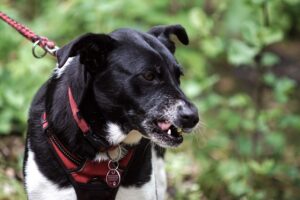
Trigger stacking can be known as stacking or stressor stacking.
Like us, circumstances, events or bad memories can overwhelm us or make us feel frightened, and if too much happens in a short time span, we go bang.
Puppies and dogs are the same. Each scary event stacks on top of one another too quickly, and eventually, something, however small, tips a dog over the edge, and a dog is ‘above threshold’. The result is biting, lashing out, lunging, and snarling at you, others or animals.
Looking back, this means negative situations that your dog has not coped with and, when encountered often, feels panic again and again. Eventually, normal everyday things a dog coped with suddenly overwhelm it too.
A dog will give gentle warning gestures that it feels uncomfortable. You may not notice the signs if you aren’t aware of the Ladder of Aggression. This highlights minor to medium to dangerous signs and outcomes.
So, a dog’s stress increases, stacks up, peaks, and when in the red zone of the Ladder of Aggression, a dog will show an extreme reaction. If a dog bites or kills someone, the consequence can be euthanasia.
How is the hormone cortisol connected to doggy stress?
Cortisol is the body’s natural stress hormone.
An accumulation of worrying situations can make your dog anxious, fearful, scared, feel panic and stressed, and trigger stacking occurs until a fight-or-flight response happens. By now, the body’s natural hormone is released, causing an extreme reaction out of character.
A dog now needs to decompress.
What does ‘below threshold’ mean?

Your dog is showing signs of fear and anxiety and minimal signs it cannot cope. At this stage, a dog has not reached the point of an extreme reaction.
There is time to help a dog by avoiding or removing it from situations it feels threatened or fears.
What does ‘above threshold’ mean?
Stress levels have peaked, and a dog is likely to have an extreme reaction if tipped over the edge by one final negative situation or an event a dog normally coped with.
As you can see in the red zone shown in the Ladder of Aggression, a dog will display the following:
4th: Stiffening up and staring
3rd: Growling
2nd: Snapping
1st and final: Biting
By now, a dog will be unable to focus on your commands or you.
What is the Ladder of Aggression?
Put simply, the Ladder of Aggression gives dog owners a guideline of minor to average to dangerous stress levels in a dog. Take note of the body language as your dog communicates with you and start helping your dog when stress levels are in the green zone, then work on identifying the cause before levels increase.
Red
| Dangerous |
|---|
| (final) Biting |
| Snapping |
| Growling |
| Stiffening up, staring |
Orange
| Full Alert |
|---|
| Lying down, leg up, exposed belly |
| Standing crouched Tail tucked under |
Yellow
| Start Taking Notice |
|---|
| Creeping Ears back |
Green
| Early Warning Signs |
|---|
| Walking away |
| Turning body away Sitting Pawing |
| Turning head away |
| Yawning Blinking Nose licking |
Do you recognise any of the above in your dog?
A true story involving a Border Collie
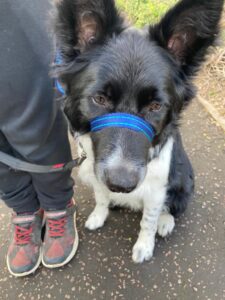
A puppy was born on a farm and allowed freedom rather than early training. Bertie went to live with a single working Mum and school-age son – he loved the boy but also displayed the notorious behaviour of a border collie. Bertie was given everything, including love, that he could want, including canine training school. He was neutered but reacted to, as diagnosed by the vet, anaesthetic, but we now think it was a part of trigger stacking.
Here is a breakdown of Bertie’s life:
- He went to live with his dog trainer from training school
- His dog trainer gave him up
- The original owners found him a place at a fantastic Border Collie rescue called Wiccaweys
- A couple adopted him, but they returned Bertie to the rescue after 7 days
- A volunteer at the rescue gave Bertie a home alongside her three rescue dogs
- Bertie was happy, displayed high energy levels and loved it when his original owners visited, especially the son. Bertie wanted the child’s attention only and snuggled up to him, showing his love
- Other dogs and people visited his current home
- Eventually, Bertie displayed stress and reached the red zone
- He now lives with a single man and no other dogs
We think the events and circumstances of Bertie’s life stacked up during his short life. At first, we thought he needed the company of other dogs, but he is now much calmer and happier as the only pet living with one person in a home. Visitors stay a short time and leave. Bertie copes.
From this, we can see the importance that every animal needs to be in the right home environment, regardless of the love you give and what you provide for the care and welfare of that pet.
It has been decided between the original owner and the previous owner that ties are cut for the benefit and continuation of Bertie’s progress.
The original family, Wiccaweys, previous owner and current owner all worked together to support, care, love and find Bertie the home he needed.
How to avoid Trigger Stacking?
Hopefully, you can see your dog is trigger stacking. Remember, your dog is an individual; what one dog can cope with, another will not.
Some dog trainers believe in desensitising dogs by repeatedly introducing them to stressful situations, which could make your dog more stressed and anxious. Dog trainers call it ‘flooding’. So then, if a dog does not have time to decompress between worrying situations, cortisol levels will not drop, and a dog may not recover adequately from stress.
A qualified dog trainer will assist a pet owner using the correct method and may one day introduce a dog to stressors slowly, at a safe distance, and reward for calm behaviour.
For regulated dog trainers and behaviourists, please scroll down.
How to help a dog that is ‘above threshold’.
Even though I say be observant of your dog, and any warning signs it displays and remove it from situations that may cause stress, it won’t always be possible. For example, you cannot control fireworks being let off at different times of the year, sudden loud noise, a dog barking, or bad weather.
If you know your dog has a nervous deposition, keep it on a short lead on a walk and ensure you have purchased suitable accessories for your dog; if people approach, ask them to keep their distance. And if your dog is coping with a particular situation, offer a reward.
Yellow is the recognised colour of a nervous dog and red is for a reactive dog. These are ideas of accessories you can buy for you and your dog.
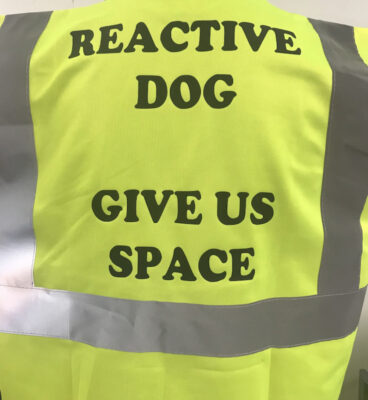
Orion Belt Retailer
Orion Belt Retailer sells hi-viz vests for you. Available in orange, pink, blue, Black or yellow, with black text on the front and back, and sizes small to 3XL.
Unfortunately, there isn’t one for ‘nervous dog’.
Options:
Dog in training
Reactive dog
Do not approach or Give us space
Review: ” I asked for a couple of paw prints to be added to the jacket, which they did.”
Forth Promotions Limited
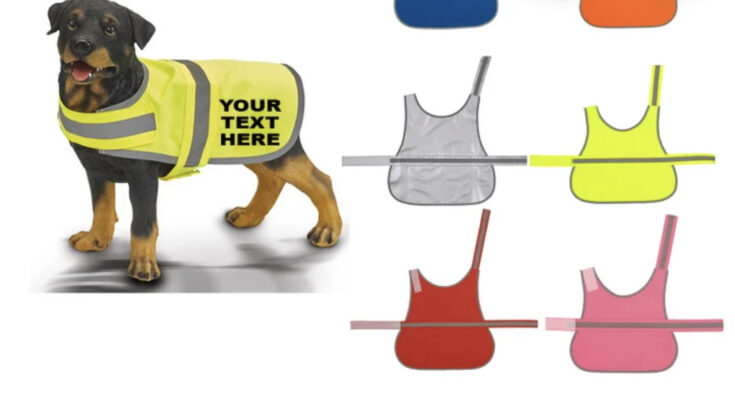
Forth Promotions Limited have hi-viz dog coats in yellow, grey, orange, pink, red or blue and sized small to large.
You can personalise with your own text choice, which is helpful. The listing gives an example text:
Options:
Hi Viz only, 1-sided or 2-sided print
No Dogs! Leave space or Nervous dog – keep back
Review:
“It is great quality and personalised to say exactly what I need.”
Amelia’s Little Gifts
A more cost-effective option is to use a lead or harness warning wrap. It secures with a rip-strip closure.
Amelia’s Little Gifts will personalise the wording of your choice, so, for example, you could choose ‘reactive’ or ‘nervous dog’ in a print area of 15cm x 3.5cm. The wrap is available in orange, yellow, black and red.
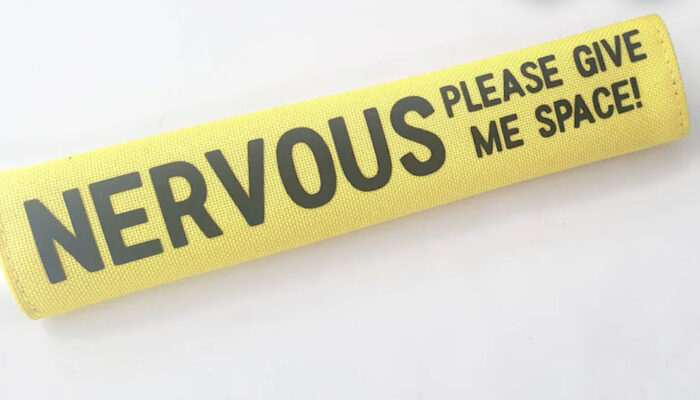
For the wording to show, the wrap is more effective on thicker lead. I recommend visiting the seller’s shop as she sells a selection of medical emergency products suitable for us and pets too.
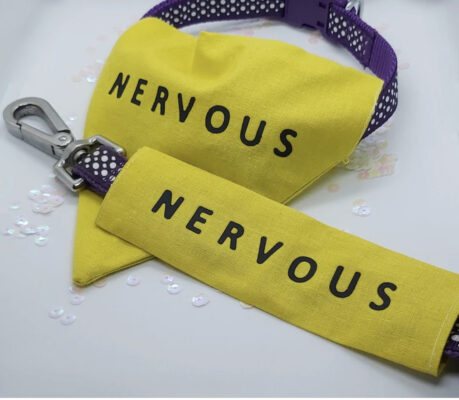
Pet Accessories
Pet Accessories handmakes a bandana and lead wrap set, or you can buy singularly. There is a choice of ‘nervous’ or ‘in training’ in small, medium or large.
Review:
“Fits perfectly onto Zoe’s collar.”
Related articles:
- Training a Romanian Street Dog – How this owner succeeded
- Adverse Effects of Puppy Castration
- Notorious Behaviour of a Border Collie
- Adopting a Romanian Street Dog – Our dog Teddy
- A True Story of Puppy Farming – A Border Collie called Nell
- Worse & Best Leads, Harnesses and Car Safety
How to help a dog decompress
When your dog is stressed, it needs time to decompress; home is the best place. Quiet time is essential for stress levels to drop, so sleep, foraging, or a chew toy are ideal. During decompression, or recovery time, cortisol (stress) levels will decrease, but it can take over 72 hours to drop to normal levels. Optional calming complementary spray or supplement may benefit.
Keep a diary about your dog’s behaviour. Observe your dog’s behaviour in different situations and avoid locations, people, or breeds or whatever is identified as the stressor. Help your dog by removing it from the situation causing anxiety.
Related questions:
How do I find out if a dog behaviourist is qualified?
The Animal Behaviour and Training Council (ABTC) represent people in the animal business. This includes animal behaviourists, therapists, trainers, and training instructors. The council sets the standard of practical skills and knowledge for people to work in these fields.
Where can I find a dog behaviourist in my area?
The ABTC also maintain a national register of qualified animal behaviourists and trainers. Find an animal behaviourist or trainer.

